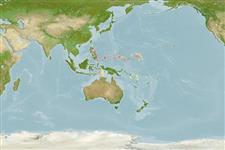>
Gobiiformes (Gobies) >
Gobiidae (Gobies) > Gobiinae
Etymology: nannai: Named after the Sumerian moon god, Sin, who had several names corresponding to its different phases; the name 'Nanna' represented the full moon, in allusion to the moon-like lateral spots on the body..
More on authors: Winterbottom, Iwata & Kozawa.
Environment: milieu / climate zone / depth range / distribution range
Ecologia
marino demersale; distribuzione batimetrica 5 - 20 m (Ref. 90102). Tropical
Distribuzione
Stati | Aree FAO | Ecosystems | Presenze | Point map | Introduzioni | Faunafri
Western Pacific: Palau and the Philippines.
Size / Peso / Age
Maturity: Lm ? range ? - ? cm
Max length : 3.3 cm SL maschio/sesso non determinato; (Ref. 53948); 3.0 cm SL (female)
Spine dorsali (totale): 7; Raggi dorsali molli (totale): 11; Spine anali 1; Raggi anali molli: 11; Vertebre: 26. This species is distinguished by the following characters: shares with Vanderhorstia papillo the elongated 5" (upper lobe) and 9" (lower lobe) branched caudal fin rays; differs from V. papillo in having more lateral scales (41-45 vs. 27); no scales in the predorsal midline (vs. 11); a unique color pattern (off-white background with large yellow spots along the midlateral body vs. such spots absent, and absence of four dark gray brown saddles on body vs. present); adults with both third and fourth dorsal spines elongate; more lower gill rakers on the first arch (16-17 vs. 10); fewer pseudobranch filaments (6-7 vs. 9); a single papilla in row c on the cheek (vs. 4) and row b not interrupted (vs. in two sections) (Ref. 53948).
Based on a photo taken from the Philippines, it is reasonable to assume that it is associated with burrows made and occupied by alphaeid shrimps (albeit no visible evidence of the shrimp in the image), as is the case in all it congeners for which information is available (Ref. 53948). Found in sand-rubble bottoms in 5-20 m (Ref 90102).
Life cycle and mating behavior
Maturità | Riproduzione | Deposizione | Uova | Fecundity | Larve
Winterbottom, R., A. Iwata and T. Kozawa, 2005. Vanderhorstia nannai, a new species of burrow-associated goby from Palau and the Philippines (Pisces: Gobiidae). aqua, J. Ichthyol. Aquat. Biol. 9(3):109-114. (Ref. 53948)
IUCN Red List Status (Ref. 130435)
Threat to humans
Harmless
Human uses
Informazioni ulteriori
Nomi ComuniSinonimiMetabolismoPredatoriEcotossicologiaRiproduzioneMaturitàDeposizioneSpawning aggregationFecundityUovaEgg development
Age/SizeAccrescimentoLength-weightLength-lengthLength-frequenciesMorfometriaMorfologiaLarveDinamica popolazioni larvaliReclutamentoAbbondanzaBRUVS
BibliografiaAcquacolturaProfilo di acquacolturaVarietàGeneticaElectrophoresesEreditarietàMalattieElaborazioneNutrientsMass conversion
CollaboratoriImmaginiStamps, Coins Misc.SuoniCiguateraVelocitàModalità di nuotoArea branchialeOtolithsCervelliVista
Strumenti
Special reports
Download XML
Fonti Internet
Estimates based on models
Preferred temperature (Ref.
123201): 28.7 - 29.4, mean 29 °C (based on 212 cells).
Phylogenetic diversity index (Ref.
82804): PD
50 = 0.5000 [Uniqueness, from 0.5 = low to 2.0 = high].
Bayesian length-weight: a=0.00708 (0.00333 - 0.01504), b=3.09 (2.92 - 3.26), in cm total length, based on LWR estimates for this (Sub)family-body shape (Ref.
93245).
Trophic level (Ref.
69278): 3.1 ±0.3 se; based on size and trophs of closest relatives
Resilienza (Ref.
120179): Alto, tempo minimo di raddoppiamento della popolazione meno di 15 mesi (Preliminary K or Fecundity.).
Fishing Vulnerability (Ref.
59153): Low vulnerability (10 of 100).
